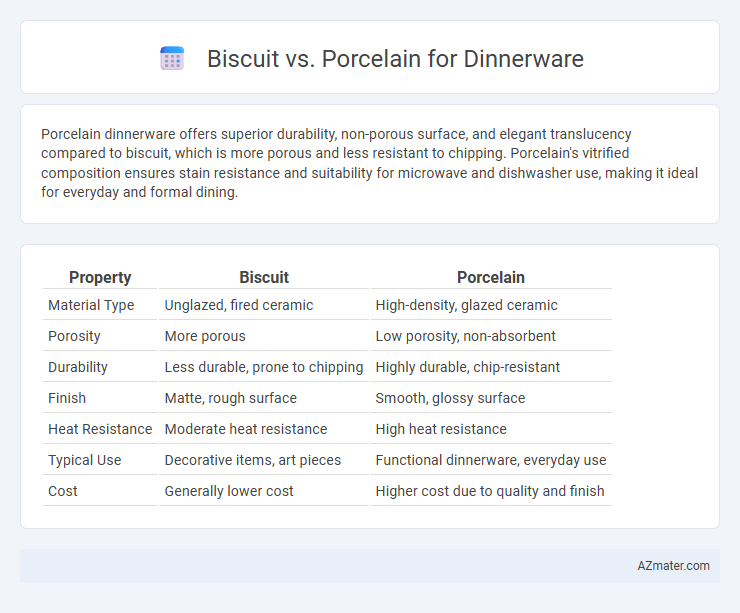Porcelain dinnerware offers superior durability, non-porous surface, and elegant translucency compared to biscuit, which is more porous and less resistant to chipping. Porcelain's vitrified composition ensures stain resistance and suitability for microwave and dishwasher use, making it ideal for everyday and formal dining.
Table of Comparison
| Property | Biscuit | Porcelain |
|---|---|---|
| Material Type | Unglazed, fired ceramic | High-density, glazed ceramic |
| Porosity | More porous | Low porosity, non-absorbent |
| Durability | Less durable, prone to chipping | Highly durable, chip-resistant |
| Finish | Matte, rough surface | Smooth, glossy surface |
| Heat Resistance | Moderate heat resistance | High heat resistance |
| Typical Use | Decorative items, art pieces | Functional dinnerware, everyday use |
| Cost | Generally lower cost | Higher cost due to quality and finish |
Introduction to Biscuit and Porcelain Dinnerware
Biscuit dinnerware, also known as unglazed porcelain, features a matte, porous surface that enhances tactile appeal and offers a natural aesthetic. Porcelain dinnerware is characterized by its smooth, glossy finish achieved through a high-temperature glazing process, providing increased durability and resistance to stains. Both types maintain the strength and elegance of fired clay, with biscuit offering a rustic charm and porcelain delivering a refined, polished look ideal for formal dining.
What Is Biscuit Dinnerware?
Biscuit dinnerware refers to unglazed porcelain that retains a matte, porous surface, often used for decorative or functional pieces. Unlike fully glazed porcelain, biscuit ware showcases a natural, unfinished look that emphasizes texture and detail. It is prized for its delicate appearance but requires careful handling due to its more absorbent and less durable surface.
What Defines Porcelain Dinnerware?
Porcelain dinnerware is defined by its high-density composition, consisting primarily of kaolin clay, feldspar, and quartz, which is fired at extremely high temperatures around 1,200 to 1,400 degrees Celsius. This firing process results in a strong, vitrified, and translucent material that is both chip-resistant and non-porous, making it ideal for daily use and fine dining. Unlike biscuit porcelain, which is unglazed and matte, porcelain dinnerware is typically finished with a smooth, glossy glaze that enhances durability and aesthetic appeal.
Key Differences in Material Composition
Biscuit porcelain, also known as bisque, is unglazed and fired at high temperatures, resulting in a matte, porous surface that emphasizes texture and raw material qualities. In contrast, traditional porcelain dinnerware features a glassy, smooth glaze that seals the surface, making it more resistant to stains and easier to clean. The material composition difference lies in biscuit porcelain's unglazed finish, which absorbs liquids more readily, while glazed porcelain contains a vitrified layer that enhances durability and water resistance.
Production Process: Biscuit vs Porcelain
Biscuit dinnerware refers to unglazed porcelain that has undergone the initial firing process, resulting in a porous, matte finish ideal for detailed decoration applications. Porcelain, by contrast, undergoes a second firing with a glaze, creating a smooth, glass-like surface that is non-porous and highly durable. The production process difference lies primarily in biscuit being the raw, unglazed stage, while porcelain dinnerware completes the manufacturing cycle with glazing and finishing.
Appearance and Texture Comparison
Biscuit dinnerware features a matte, unglazed surface with a chalky texture that highlights fine details and has a natural, rustic appearance. Porcelain offers a smooth, glossy finish with a translucent quality that enhances its refined, elegant look. While biscuit is more porous and tactile, porcelain provides a sleek, polished feel that is both durable and visually striking.
Durability and Everyday Use
Biscuit porcelain, also known as unglazed porcelain, offers a matte finish but tends to be more porous and less resistant to chipping compared to fully glazed porcelain, making it less ideal for frequent everyday use. Porcelain dinnerware with a glazed surface provides superior durability and resistance to scratches, stains, and thermal shock, ensuring it withstands daily handling and dishwasher cycles. For long-term durability and practical everyday use, glazed porcelain remains the preferred choice due to its robust, non-porous finish.
Aesthetic Appeal and Design Variations
Biscuit dinnerware offers a matte, unglazed finish that highlights a natural, rustic aesthetic favored in minimalist and artisanal table settings, while porcelain dinnerware boasts a smooth, glossy surface that enhances intricate patterns and vibrant colors, appealing to classic and elegant decor styles. Porcelain's translucency allows for delicate designs and fine detailing, making it ideal for sophisticated formal dining, whereas biscuit's raw texture emphasizes handcrafted uniqueness and earthy tones. The choice between biscuit and porcelain significantly influences the visual impact and stylistic expression of dinnerware in any dining environment.
Suitability for Formal and Casual Settings
Porcelain dinnerware offers a polished, elegant finish ideal for formal dining occasions, pairing well with intricate designs and fine detailing. Biscuit, or unglazed porcelain, presents a matte, rustic appearance that suits casual, everyday settings and adds a tactile warmth to the table. The choice between biscuit and porcelain depends on the desired ambiance, with porcelain favoring sophistication and biscuit embracing a cozy, informal vibe.
Choosing the Right Dinnerware for Your Needs
Biscuit dinnerware, known for its unglazed, matte finish, offers a rustic texture ideal for casual dining and durability, while porcelain provides a smooth, glazed surface prized for its elegance and resistance to chipping, making it suitable for formal settings. Porcelain's high firing temperature results in higher density and strength, ensuring longevity and stain resistance compared to the more porous biscuit style. Selecting between biscuit and porcelain depends on lifestyle factors such as frequency of use, aesthetic preference, and maintenance commitment.

Infographic: Biscuit vs Porcelain for Dinnerware
 azmater.com
azmater.com